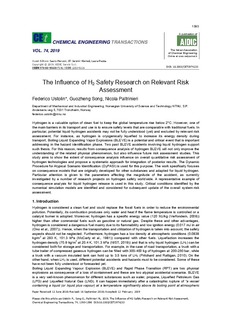The influence of H2 safety research on relevant risk assessment
Journal article, Peer reviewed
Published version

Åpne
Permanent lenke
http://hdl.handle.net/11250/2607755Utgivelsesdato
2019Metadata
Vis full innførselSamlinger
Originalversjon
10.3303/CET1974233Sammendrag
Hydrogen is a valuable option of clean fuel to keep the global temperature rise below 2°C. However, one of the main barriers in its transport and use is to ensure safety levels that are comparable with traditional fuels. In particular, potential liquid hydrogen accidents may not be fully understood (yet) and excluded by relevant risk assessment. For instance, as hydrogen is cryogenically liquefied to increase its energy density during transport, Boiling Liquid Expanding Vapor Explosions (BLEVE) is a potential and critical event that is important addressing in the hazard identification phase. Two past BLEVE accidents involving liquid hydrogen support such thesis. For this reason, results from consequence analysis of hydrogen BLEVE will not only improve the understanding of the related physical phenomenon, but also influence future risk assessment studies. This study aims to show the extent of consequence analysis influence on overall quantitative risk assessment of hydrogen technologies and propose a systematic approach for integration of posterior results. The Dynamic Procedure for Atypical Scenario Identification (DyPASI) is used for this purpose. The work specifically focuses on consequence models that are originally developed for other substances and adapted for liquid hydrogen. Particular attention is given to the parameters affecting the magnitude of the accident, as currently investigated by a number of research projects on hydrogen safety worldwide. A representative example of consequence analysis for liquid hydrogen release is used in this study. Critical conditions identified by the numerical simulation models are identified and considered for subsequent update of the overall system risk assessment.